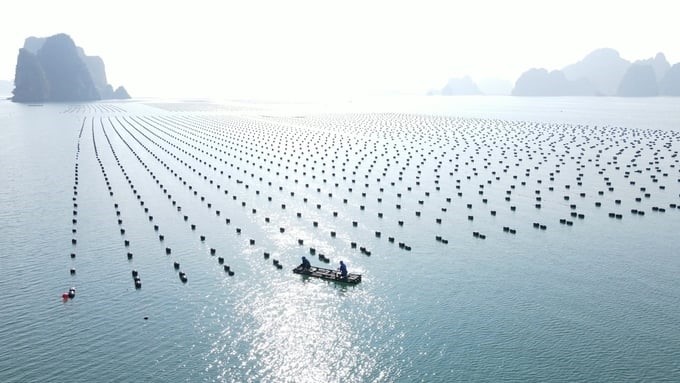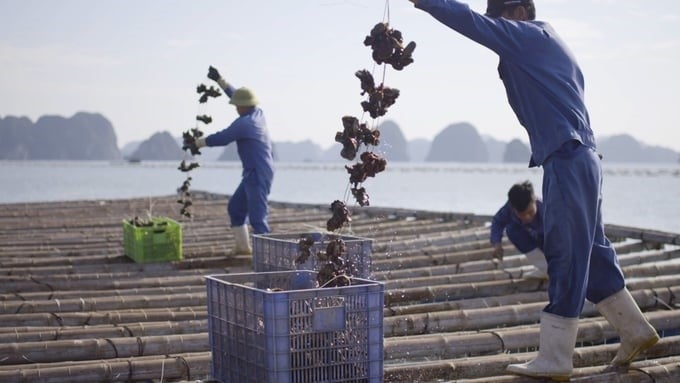November 27, 2025 | 14:18 GMT +7
November 27, 2025 | 14:18 GMT +7
Hotline: 0913.378.918
November 27, 2025 | 14:18 GMT +7
Hotline: 0913.378.918
Aquatic reserves in Vietnam's sea areas are declining. This raises the issue of converting from exploitation to natural marine farming in order to ensure livelihoods for the resident community while preserving, protecting, and developing aquatic resources.
According to the Department of Fisheries (Ministry of Agriculture and Rural Development), Vietnam has about 500,000 hectares of water surface that can be used for marine farming. In fact, many regions and localities can develop marine farming, but they are divided into four main regions. The first region is in the North, where river and sea estuaries can develop fish, mollusk, and crustacean farming. The second region is the Central Coast, which can develop large-scale sea fish farming with large yields. The third region is the Southeast, and the fourth region is the Southwest.

Vietnam has about 500,000 hectares of water surface that can be used for marine farming. Photo: Duy Hoc.
The total aquaculture area in 2023 is estimated to reach 1.3 million hectares of inland farming and 9.5 million m3 of marine cages. Of which, marine farming increased by 5.5%, including 4.3 million m3 of sea fish farming cages, 5.2 million m3 of lobster farming cages, and 57,000 hectares of mollusk farming.
Total output of marine farming in 2023 reached 789,800 tons, an increase of 10.1% compared to 2022, including 46,000 tons of sea fish, 3,800 tons of lobster, 440,000 tons of mollusk, and 300,000 tons of other objects.
"Furthermore, developing marine farming is not new; we have certain experiences and have solved a number of problems, such as seed technology and farming techniques. From both a natural and experiential perspective, we have many favorable conditions to develop marine farming," emphasized Dr. Pham Anh Tuan, former Deputy Director General of the Directorate of Fisheries.
In recent times, the Government and the Ministry of Agriculture and Rural Development have issued many policies and programs to promote the development of marine farming. Thanks to that, a number of support parts for the marine farming industry have been initially formed, such as infrastructure for seed production areas and concentrated farming areas, auxiliary industries, processing industries, consumption market development, etc.
Sharing about Vietnam's potential for marine farming, Dr. Pham Anh Tuan, former Deputy Director General of the Directorate of Fisheries, assessed that with a long coastline and large exclusive economic zone, Vietnam has a lot of potential to develop marine farming.
Besides, Vietnam's current objects of marine farming are also very diverse, from fish, crustaceans, and mollusks to seaweed species. There are objects that can be raised near the shore; some can be farmed offshore; some can make food; or some can serve as raw materials for other industries.
In addition, Dr. Pham Anh Tuan said that the demand for seafood products is increasing in the domestic market as living standards are increasingly high and incomes are improving. Seafood products not only meet food needs but also serve as raw materials for other industries, such as pharmaceuticals, cosmetics, etc. This is a favorable basis for developing marine farming.
Dr. Pham Anh Tuan raised the issue: "We had the desire to develop marine farming decades ago. If I remember correctly, there was previously an Aquaculture Development Program for the 1999–2010 period, which set a goal of reaching 200,000 tons of sea fish/year. It is true that our country's marine farming has many potentials and advantages, but why has it not developed as expected?".
Answering this question, Dr. Pham Anh Tuan said that there are many "bottlenecks" hindering the development of marine farming. First, for near-shore marine farming, almost the maximum water surface area has been utilized to develop aquaculture, leading to many problems related to diseases and the environment.
Second, some of Vietnam’s current objects of marine farming are relying too much on natural food sources, especially trash fish.
Third, there are some objects of marine farming that we are proactively raising, but the market problem only stops at a certain extent. For example, we can be proactive in grouper farming, but the market is not large. On the contrary, for objects with a large market, we have not been proactive in using technologies to develop scale.
Fourth, near-shore marine farming is overloaded. Meanwhile, offshore marine farming still has space to develop, but not everyone can boldly invest because offshore farming requires large capital, good technology, and is full of risks and challenges.

A "bottleneck" in Vietnam's marine farming development today is the output market. Identifying farming objects and scales is still a difficult problem. Photo: Duy Hoc.
Facing such challenges, Dr. Pham Anh Tuan has proposed many solutions to accelerate marine farming, such as investing in science and technology to solve the seed problem; creating favorable and appropriate mechanisms and policies to attract offshore marine farming businesses; and especially, selecting objects of marine faming suitable for the market.
“The State must plan and select a number of potential objects in accordance with market needs to invest in science and technology, research to develop seeds, feed and build technical processes, and farming technology for these objects," Dr. Pham Anh Tuan said.
Translated by Thu Huyen

(VAN) China’s cooking oil is suddenly flooding into India. It all comes down to a soybean surplus that Beijing doesn’t quite know what to do with.

(VAN) An Giang promotes supply-demand connections, standardizes quality and builds value chains, creating a foundation for sustainable bird’s nest development and aiming to expand exports.
/2025/11/24/5339-4-nongnghiep-075331.jpg)
(VAN) Recently, the conference on 'Sustainable Fisheries Linkage Chain - Tilapia for Export' took place in Tien Hai commune, Hung Yen province.
/2025/11/21/4309-2-153400_128.jpg)
(VAN) Green and low-emission rice is paving the way for Vietnamese rice to enter high-end markets, marking the beginning of a transformation journey toward greening and elevating the national rice brand.

(VAN) ‘Right to Win’ outlines a national action plan that shapes a new vision for Viet Nam’s agriculture in an era of renewal and global integration.

(VAN) Lam Dong’s farmed sturgeon output this year is expected to reach 2,300 tons, worth VND 450 billion, affirming the brand’s position on the market.

(VAN) A surge in Ukrainian egg exports, largely driven by soaring sales to the UK over the last few years, has notably pushed up egg prices on the domestic market.